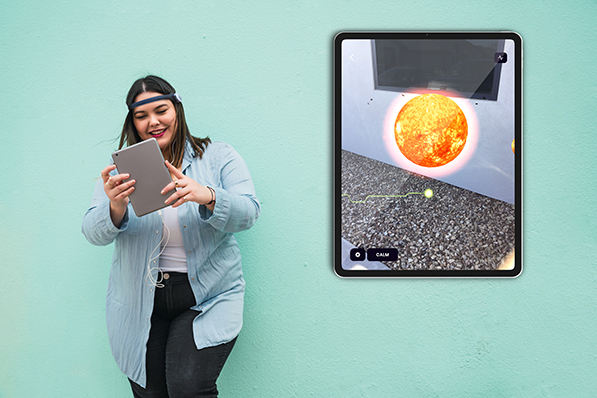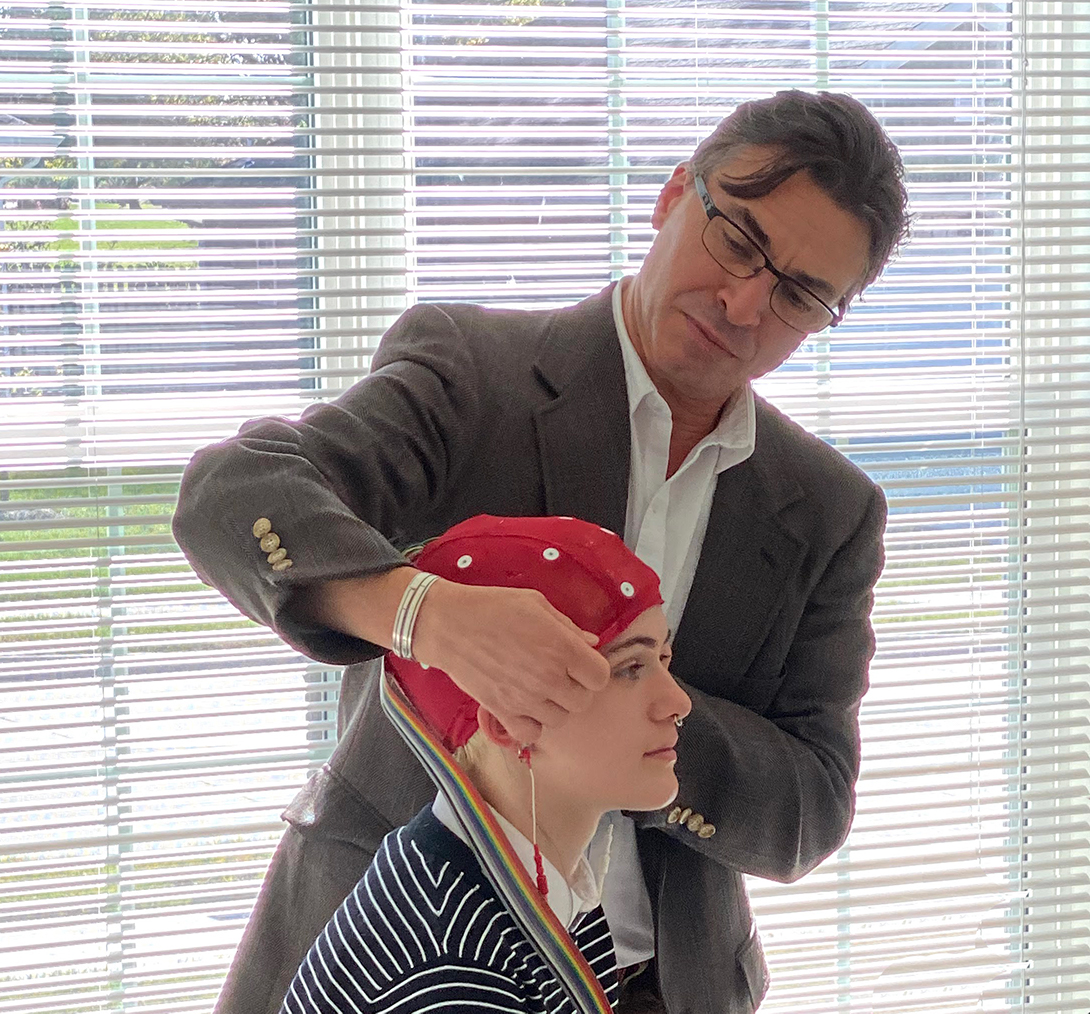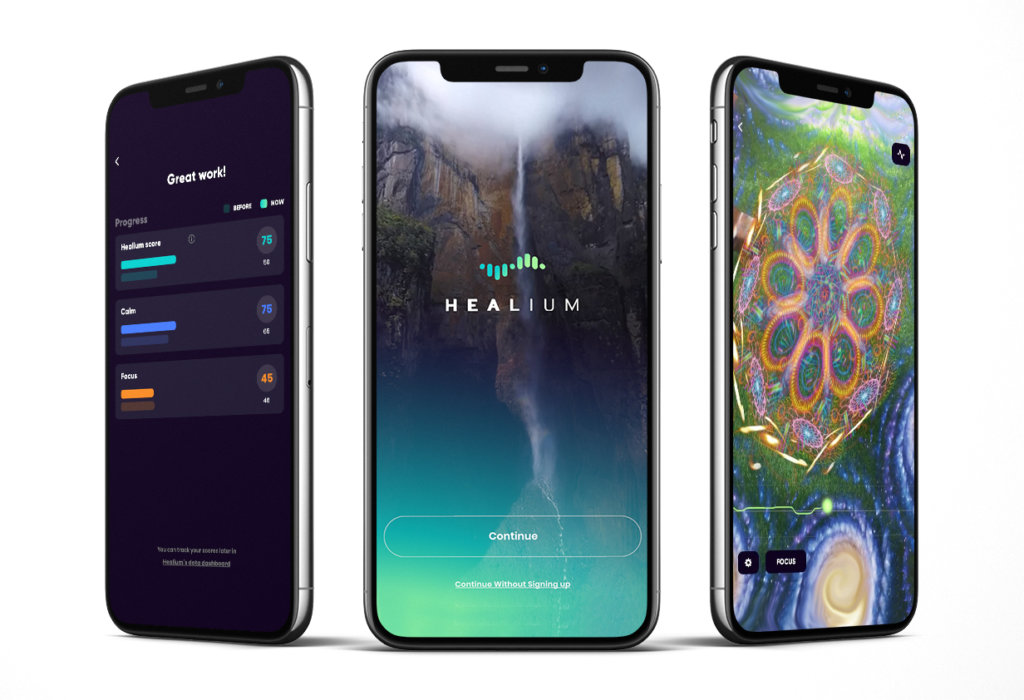




In our latest clinical study, researchers discovered augmented reality paired with neurofeedback led to high engagement during meditative experiences and an increase in positive mood states.

AR, or augmented reality uses digital images placed in the real world view of the user, usually through a phone or tablet. In simpler terms, apps like Instagram or Snapchat have been using augmented reality for years to create filters that you experience through your phone’s camera. They can be interactive, entertaining, and even educational. This technology is being adapted to fit other applications other than social media. For example, Healium’s augmented reality app is used for meditation, mindfulness, human performance, and mental fitness.
VR, or virtual reality requires special equipment like an Oculus or Pico headset. These devices block out the real world, creating a fully immersive experience all around you. As you turn your head, your gaze inside the headset moves with you in real-time, creating the illusion that you have a first-person perspective in the virtual world. This is especially helpful for the therapeutic benefits of Healium’s VR app. The brain believes what it sees.
For the purpose of this study, researchers tested Healium’s augmented reality app.
The study examined the impact of an AR meditation on an adult sample of participants who had a moderate-to-severe range of depression and or anxiety symptoms. The researchers measured negative and positive mood states and the impact of using augmented reality with or without neurofeedback.
Participants were at least 18 years old and reported levels of generalized anxiety, and/or depression symptoms at or above a moderate cutoff point. Moderate levels of anxiety and depression were defined by cutoff scores of 8 or higher on the GAD-7 and scores of 10 or higher on the PHQ-9.
The Brunel Mood Scale was used to measure the participants’ own evaluation of their feelings by asking, “how do you feel right now?” and marking their response on a 5-point scale. It was used before and after the experiment. The mood descriptors used in this study were: tension, depression, fatigue, confusion, happiness, and calmness.
Two groups were formed from random assignments. One group used augmented reality plus neurofeedback (AR+NF) during the experiment.
The other group used augmented reality only–no neurofeedback (AR−NF) condition.
The primary hypotheses were that both groups would show reductions in negative mood states with increased feelings of positive mood states, but that the addition of neurofeedback would increase these effects.
Second, researchers hypothesized that there would be a larger change in cortical activity for the AR plus neurofeedback group, compared to the AR without neurofeedback group. Specifically, researchers expected to see significant shifts in gamma activity, given that the neurofeedback protocol was designed to promote frontal asymmetric activity patterns previously linked with positive mental health states and based on previous research observing changes in gamma-related activity resulting from lovingkindness-compassion (LK-C) meditation practiced by expert meditators

Subjects were fitted with a 19-channel EEG electrocap to measure their brain wave activity and first completed a 5 minute, eyes-closed EEG baseline. Participants in the augmented reality plus neurofeedback (AR+NF) group were then fitted with the Muse headband and used an iPhone to view the Healium augmented reality app.
Participants using AR only (no neurofeedback) were simply given the iPhone to view the Healium AR app.
Immediately following the intervention, a second eyes-closed baseline was recorded for 5 min and subjects were asked to complete a second Brunel Mood questionnaire and three AR experience questions.
At the end of the study, the participants were asked to respond to three questions:
–How engaged were you in this meditation experience?
–Do you think this type of meditation application could help you manage stress or anxiety in the future?
–How likely are you to use this type of digital meditation in the future?”
In this study, researchers investigated user experience, as well as mood and electrophysiological changes resulting from a guided meditation in an augmented reality environment, with or without neurofeedback from a wearable device. Notable differences were found in user’s experiences between groups and in EEG activity at rest in the wake of the meditation experience. However, overall, the AR meditation produced highly similar effects on mood and EEG activity regardless of the inclusion of neurofeedback.
The vast majority of participants in both groups reported finding value in the AR meditation experience as a useful resource to help manage stress and anxiety. Both groups reported high levels of engagement with the AR meditation, but the AR plus neurofeedback group endorsed greater levels of engagement than the group using AR without neurofeedback.

The results of this study suggest that using augmented reality with neurofeedback provides a more engaging experience. These results could also impact consistent training efforts and app use. With longer-term, repeated use, combining neurofeedback with augmented reality may yield more powerful and lasting patterns of brain rhythm change.
When comparing a single session of Healium AR with and without neurofeedback (NF), it was found that both groups reported nearly equal increases in positive mood states (happiness, calmness) and significant decreases in negative mood states (tension, depression, fatigue, & confusion). Additionally, both groups had similar patterns of change in brain activity after the AR experience. These changes suggested a more relaxed, calm, and open psychological state. While not statistically significant, there were some trending differences in brain activity between groups. Specifically, the AR plus neurofeedback group showed increased gamma activation in specific areas of the brain associated with empathy and emotion response.
—
In the last decade, there has been a massive increase in home and mobile tech to provide health and wellbeing programs and interventions. With the global covid-19 pandemic, this demand has only increased. Developments have allowed users to experience high-quality virtual reality and augmented reality by using modern handheld devices, further expanding the reach and potential impact of many health and wellness-promoting products and services. AR interventions for mental health may be particularly powerful as they allow users to interact with virtual objects placed in the real world in real-time, and are particularly accessible, portable, and easy to use.
Read the full study here.
As part of our mission to “do no harm”, we will continue to conduct research on the effectiveness of our AR and VR apps. Read our previous clinical studies to find out more.
To experience our AR app for yourself, download it for your mobile device today.